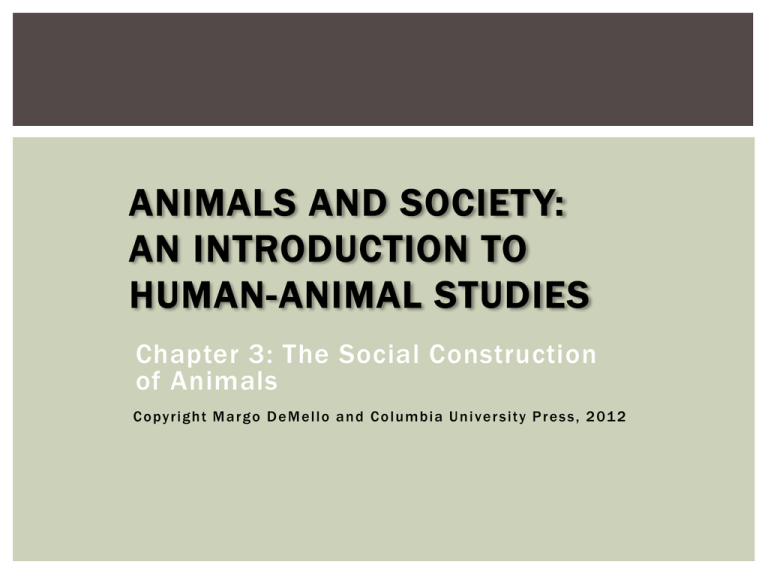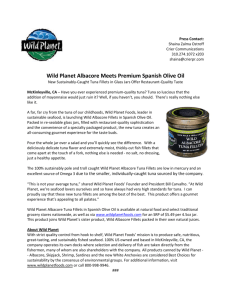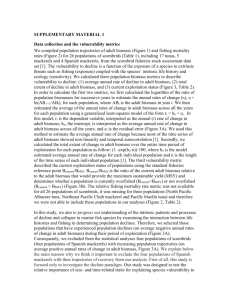Social Construction of Animals: Human-Animal Studies
advertisement

ANIMALS AND SOCIETY: AN INTRODUCTION TO HUMAN-ANIMAL STUDIES Chapter 3: The Social Construction of Animals C o py r i g h t M a r g o D e M e l l o a n d C o l um b i a U n i v e r s i t y P r e s s , 2 01 2 How do we classify animals in society today? What is it? •Wild rabbit? •Pet rabbit? •Lab rabbit? •Meat rabbit? •Fur rabbit? •Easter rabbit? What protections this animal deserve under the law differ according to how this animal is used, which itself governs how it is classified. Biological Systems of Classification Linnaean Taxonomy Other Systems of Classification Christian Theology In Medieval Europe, animals were generally classified according to Christian theology. While all animals were seen as lower than human—and further from God—some were more elevated than others. For example, carnivores like lions and eagles sat at the top of the hierarchy of animals, while vegetarians and domesticated animals sat at the bottom. The folklore of the time created animal heroes who exhibited characteristics like bravery, cunning and intelligence, and other animals who were seen as hapless, stupid, or weak. Animals could be noble, evil, or pure. Wild or Tame? Another major way in which we have classified animals has to do with where they live, and whether or not they are part of human culture. In this scheme, animals are either wild—living outside the bounds of culture—or they are tame—living inside of human culture. In this view, whether or not an animal has been domesticated—selectively bred and controlled by humans—is the deciding factor as to whether that animal will be considered wild or not. Animals who live in a zoo, for example, almost always come from the wild (no one would visit a zoo to see a dog, after all), but how wild are they, once they live behind a fence and are fed and raised by humans? Feral animals, or animals who were once domesticated but now live in the wild, provide another categorical problem, with real implications for animal lives. Wild vs. Tame (Outside of culture and inside of culture) Biblical: Fit for Sacrifice In all cultures, some animals are considered edible and others are considered inedible. Among Jews and Muslims, for example, pigs, shellfish, reptiles, and many other animals are considered inedible. In the United States, dogs, cats, and horses are inedible, while in some cultures, fish, insects, deer, camel or deer are not to be eaten. Related to the question of whether an animal is edible or not is whether the animal is fit to be sacrificed as part of a religious ritual. Biblical: Fit for Sacrifice Totem Animals Totem animals are another example of a system of classification that includes animals. A totem is an animal which is considered to be spiritually related to a clan or a tribe, and is generally considered to be ancestral to a group of people. Today, some people who are not part of a totemic culture have adopted the concept of a totem, which they see as a sort of spiritual helper or guardian. Totems are a way not just of classifying animals but of classifying the natural and cultural world: who and what are related to each other, and, often, who and what are considered edible. Who eats whom Locomotion What are the systems of classification used here? How Does One Become a Type of Animal? How do we come up with these categories? Is there something about a dog, for example, that MAKES it a pet, and not meat? Why? Is it something about the dog? Or is it humans? Or is it something about the intersection between the human and the dog, in a particular cultural place and time? Use Value “We deny species their being through reference to animals based on their function from a human point of view: pet animals, lab animals, farm animals.” -- Ken Shapiro This is not just any classification scheme. It is one that both classifies and sets out the ways that we will use these animals. Use Value Livestock Pets Laboratory Animals Circus Animals Working animals How does one become each of these categories? How does one become a pet? A pet is one who is both in a human household, and is named. Naming them incorporates them into our social world and allows us to use their name as both a term of address and a term of reference. In both cases, this allows for interaction and emotional attachment. By telling about them to others, the animal then gains a history, a biography, a subjectivity. All of this remains even after the animal is dead. A lab animal, meat animal or fur animal is both one who is spatially separate from a pet animal. They are NEVER in a home. They also never get a name. They are objects, not subjects. They have no history, no biography, no intentions, and no emotions. They live in a space where they are crowded with others, reducing their individuality; they are handled rarely, when necessary, reducing an emotional connection; they are given numbers if necessary to refer to them (but not to address them); they do not feel pain so they are not anesthetized nor killed with humane methods; and they have no agency, no ability to control their own lives. Ultimately, they are a product. The Sociozoologic Scale The Sociozoologic Scale Since the time of Aristotle, humans have always ranked higher than animals; the sociozoologic scale ranks animals in a structure of meaning that allows humans to define, reinforce, and justify their interactions with other beings. Those at the top deser ve more privileges and those at the bottom have earned their poor place in society. In other words, animals can be dif ferent things to dif ferent people: a beloved Labrador can be a best friend, a chicken can be dinner, a sea otter can be local color, a lab rat can be a research subject. And how we respond to their loss tells us a lot about the value we place on them: while we mourn the passing of a pet, we tend to write of the death of lab animals as a "loss of data.” Good animals are pets and tools (farm, lab, and work animals). They allow us to use them and thus are nicely incorporated into human culture. Bad animals are vermin and pests, who both stray from their proper place and also resist being used. Rats, for instance, can be both a good animal and a bad animal. These categories involve defining the animal to fit the categor y, and then applying cer tain treatment to them. Cow = food, and thus the cow is made to be killed and eaten. Sept . 9, 2005 : Amid the hear t -wrenching moments of devastation from deadly hurricane Katrina, there is at least one bright spot. Snowball, a small white dog taken by police from a sobbing little boy as he and his family were boarding a bus at the Superdome, has been located, USA Today repor ted Thur sday. Snowball is now at the Louisiana SPCA in Gonzalez, La., and will be reunited with his owner, veterinarian Terr y Conger told the newspaper. When the police took the dog during the Superdome evacuation, the boy cried "Snowball! Snowball!" until he vomited. At the time authorities said they didn't know where the boy or his dog ended up. The sad stor y of Snowball prompted an outpouring of emotion from pet lover s around the countr y who went on the hunt for the boy and his dog. One woman set up a reward of fer to encourage the search for Snowball. The media jumped on the stor y of Snowball. But few wrote about millions of chickens that perished in the af termath of Katrina. Why? Koalas rank high on the sociozoologic scale: they are cute and, therefore, we want to save them. WHO SWIMS WITH THE TUNA? In an essay called "Who Swims with the Tuna", David Quammen asks: why do we worry about trapping dolphins in tuna nets, and not worry about the tuna trapped in tuna nets? The killing of dolphins is a national outrage; the killing of tuna is a given. Furthermore, on our grocery shelves nowadays we find cans of a product called dolphin-safe tuna. But no tuna-safe dolphin. But why? WHO SWIMS WITH THE TUNA? One of these animals breathes air. The other doesn't. One is a mammal, one isn't . One is known for its intelligence, one isn’t. One seems to have an elaborate system of social behavior and one doesn't. One has performed altruistic and astonishing rescues of human swimmers; the other is prized for sushi. One shrieks with terror and squeals with pain. The other maintains a stoic silence. There's no question that dolphins have an unmatched appeal to us humans. From our point of view, it's a special kinship. They are bright, sophisticated, cheery, generous, perceptive, af fectionate, and yet mysterious —all the things that we value in our friends. They seem to possess important secrets. They seem to reciprocate our infatuation. Plus they consent to let us swim with them. On the other hand, who swims with the yellowfin tuna? The answer is that dolphins do. A New System of Classification Ultimately, there are as many systems of classification as there are animals and cultures. Rabbits can be pet, food or tool; they can be sacred or sacrificial; they can be separate from humans or can share with them a language and culture. If these systems of classification that we have been discussing are all, essentially, just stories, can we create a new story that is more inclusive and humane? Can we conceive of one that does not rank animals on the basis of their importance to us, but on some other characteristic? Or one that does not rank them at all? One possibility would be to try to flip things around: to try to see the world through animals’ eyes rather than to try to see and understand animals through our own eyes. “Christmas? Christmas means dinner, dinner means death! Death means carnage; Christmas means carnage!” Ferdinand the Duck, Babe (1995)









